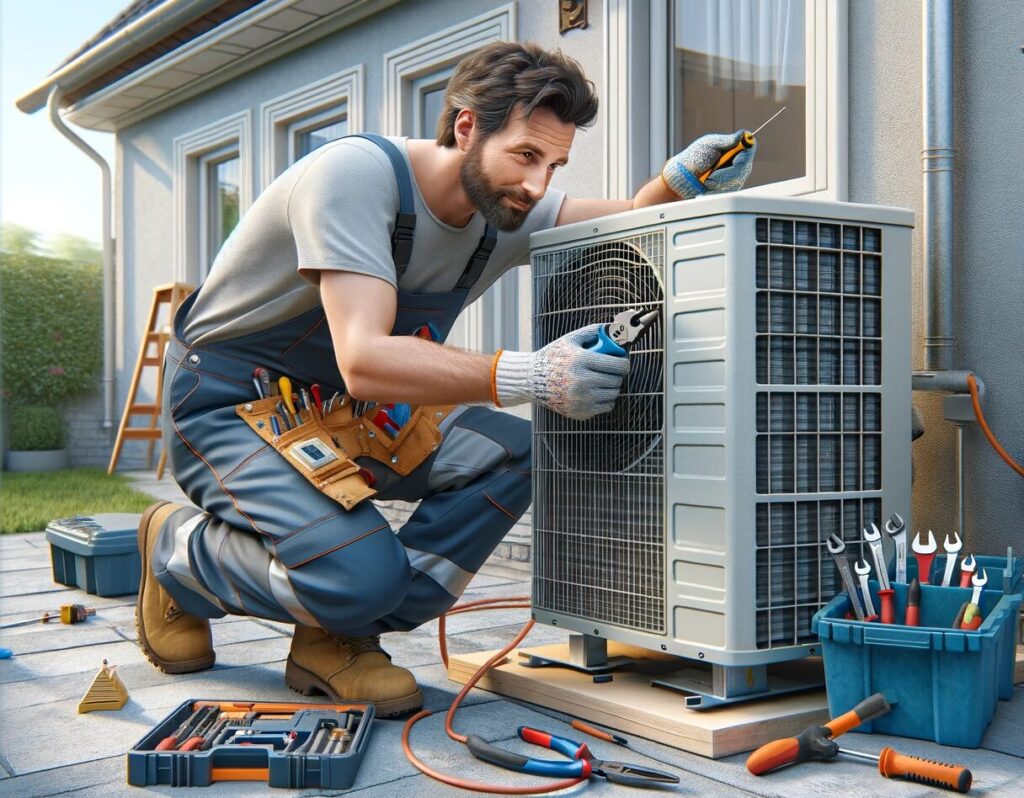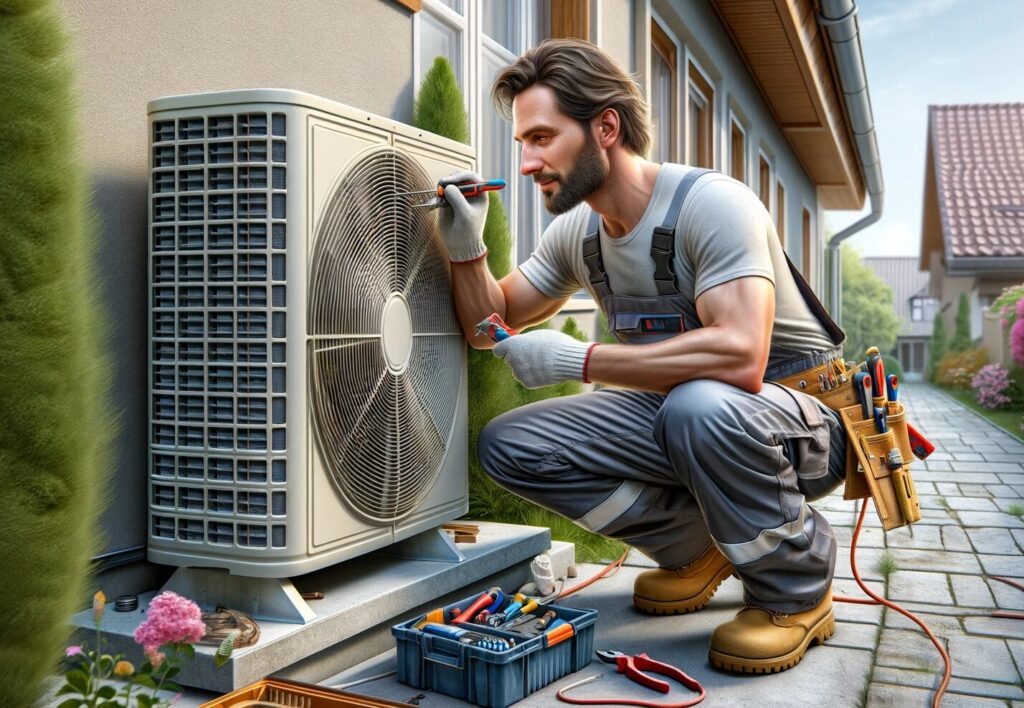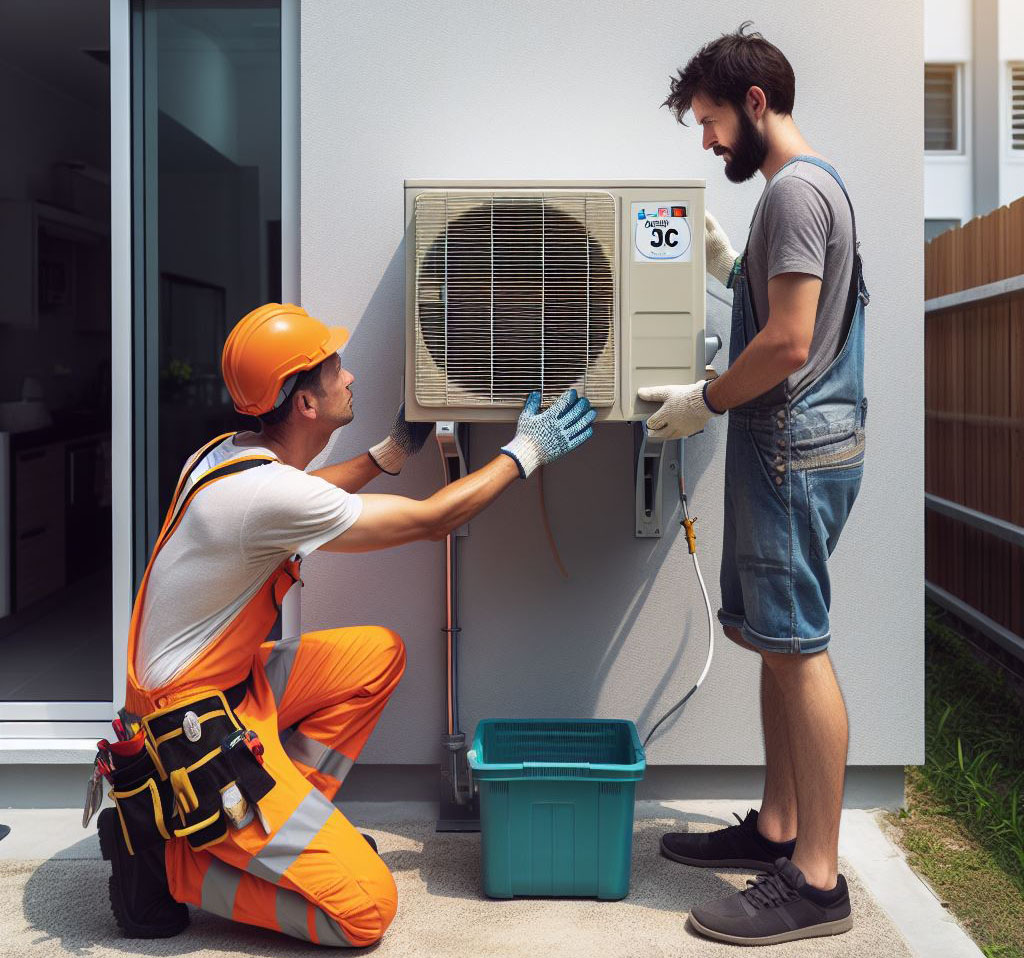Imagine it’s the peak of summer, the kind of day when the sun beats down like a hammer on an anvil, and you’re looking forward to the sweet relief of your home’s air conditioning. But as fate would have it, your outside AC unit sits silent, as still as a pond with no breeze. This isn’t just an inconvenience, it’s a red flag for homeowners and construction aficionados alike. Addressing this issue swiftly isn’t just about reclaiming your comfort—it’s about safeguarding the heart of your home’s climate control system and ensuring it runs at peak efficiency.

Understanding Your AC System
To get to the root of the problem, you need a solid grasp of your AC’s anatomy. Your system is a duo: the inside unit, known as the evaporator, cools the air within your home, while the outside unit, the condenser/compressor, is tasked with expelling the heat. It’s a classic case of teamwork, where both players must be in sync for the cooling magic to happen.
Common Reasons for an Outside AC Unit Not Turning On
Power Issues
- Tripped breakers: These are your first line of defense against electrical mayhem. They’re designed to trip when they sense an overload, cutting power to prevent damage. A quick inspection and reset of the breaker might be all it takes, but if it’s a recurring theme, you’ve got an underlying issue that needs attention.
- Blown fuses: A blown fuse is a telltale sign of an electrical hiccup. Replacing a fuse is straightforward, but it’s crucial to understand what caused the blowout to avoid future trips to the fuse box.
- Power supply problems: If the power’s out across the board, you’ll need to check if the issue extends beyond the AC unit. It could be a local outage or a more significant wiring concern.
Thermostat Troubles
- Incorrect settings: It’s the equivalent of misreading blueprints—it leads to unintended outcomes. Double-check that your thermostat is set to ‘cool’ and not accidentally left on ‘heat’ or ‘fan only’.
- Malfunctioning: Like any piece of technology, thermostats can glitch. Sometimes a simple reset can recalibrate the system and restore order.
- Battery issues: Weak or dead batteries can leave your thermostat unresponsive. A fresh set of batteries can be the quick fix you need.
Overheating
Much like a motor running too hot, your AC unit can overheat and shut down to cool off. Give it time to rest, then clear any debris that might be smothering it, restricting airflow.

Refrigerant Levels
Refrigerant is the lifeblood of your AC system. If levels run low, possibly due to a leak, the system can’t cool effectively. This is a fix that requires a certified technician with the right tools and expertise.
Capacitor Problems
The capacitor’s job is to jumpstart the unit, much like a starter cranks an engine. If it fails, you’ll likely hear a clicking sound, but the unit won’t spring to life. This component often bears the brunt of electrical stress and heat, so it’s a common point of failure.
Contactor Issues
The contactor is the relay switch that tells your AC to kick into gear. If it’s burnt or pitted, the electrical flow is interrupted, and the unit remains dormant.
In the world of home maintenance, knowledge is as valuable as the right tool for the job. With a keen eye and a bit of know-how, you can often pinpoint the issue with your AC unit. But remember, when it comes to electricity and refrigerants, caution is the name of the game. Don’t hesitate to call in a professional when the problem is beyond your comfort zone. Your home’s comfort system is a vital component of your living space, and keeping it in top shape is a task worth its weight in gold.
Troubleshooting Steps
Safety First
As with any renovation task, safety is paramount. Before you begin, ensure that the power to the AC unit is switched off. This is akin to laying down drop cloths before painting – it’s a fundamental step that sets the stage for a safe and effective work environment.
Inspect Power Sources
Begin with the basics: the power source. Check your home’s circuit breaker or fuse box. A tripped breaker or a blown fuse can be as disruptive as a misplaced stud in a wall frame – it’s essential to the structure’s integrity. Reset any tripped breakers and replace blown fuses, but keep an eye out for reoccurrences, which could indicate a deeper electrical issue.
Thermostat Check
The thermostat is the command center of your AC system. Confirm that it’s set to “cool” and that the temperature setting is below the current room temperature. If the thermostat is digital, ensure that its batteries haven’t run out of juice – a simple issue that’s often overlooked but easily remedied.
Assess the Capacitor and Contactor
Examine the capacitor and contactor within the outdoor unit. These components are the starters and relays that signal your AC to power up, much like the ignition system in a car. Look for signs of wear, overheating, or damage – any of which could prevent your AC from starting. Testing these parts might require a multimeter, and if you’re not familiar with electrical testing, it may be best to leave this to a professional.
Check for Signs of Overheating
Inspect the unit for signs of overheating, such as discoloration, a burnt smell, or a tripped pressure switch. Overheating can be the result of various issues, from a clogged filter to inadequate airflow – it’s a symptom of a system that’s been pushed beyond its limits.
Refrigerant Levels
Refrigerant levels are critical to your AC’s performance, they’re the equivalent of the proper mixture of concrete for a foundation. Low levels can indicate a leak or that the system was undercharged. Checking and handling refrigerant is a job for licensed professionals who have the tools and expertise to do it safely and effectively.

When to Call a Professional
It’s important to recognize the point at which DIY troubleshooting transitions into the realm of professional repair. Working with refrigerant or electrical components carries inherent risks and requires specialized knowledge and certifications. It’s akin to understanding when a job requires not just a carpenter, but a master craftsman.
If your troubleshooting hasn’t resolved the issue, or if you’re uncomfortable at any point, it’s prudent to call in a professional. There’s no substitute for the experience and training that a licensed HVAC technician brings to the table. They can diagnose issues that aren’t immediately apparent, handle the complexities of refrigerant management, and ensure that your system operates safely and efficiently. Remember, the goal is not just to make a repair but to ensure the longevity and reliability of your home’s cooling system.
Preventative Maintenance Tips
Regular Cleaning and Inspection of the Outside Unit
A well-maintained outside unit is the cornerstone of an efficient AC system. Much like the routine care of power tools ensures their longevity, regular cleaning and inspection of your AC unit are vital. At least once a season, remove any leaves, dirt, or debris that could impede airflow—think of it as preventative care, akin to oiling a saw before cutting.
Changing Filters and Clearing Debris from Around the Unit
Filters are your first line of defense against indoor air pollution, and they directly affect your system’s performance. Replace them every 30 to 90 days, depending on usage, to ensure your AC doesn’t have to labor unnecessarily. Similarly, keep the vicinity of your outdoor unit clear of obstructions—a minimum of two feet is a good rule of thumb, much like keeping a workspace clear to prevent accidents.
Scheduling Professional Maintenance to Ensure System Longevity
Seasonal tune-ups by a qualified technician can greatly extend the life of your AC system. It’s akin to having a seasoned carpenter inspect a home for potential issues—it’s an investment in expertise. A professional can calibrate your system for optimal performance, much like a fine-tuning of a level before laying a beam.
DIY Fixes vs. Professional Repairs
Understanding Which Issues Can Be Safely Addressed by a Handy Homeowner and Which Require Professional Expertise
Tackling minor issues like replacing a thermostat battery or resetting a tripped breaker can be within a homeowner’s wheelhouse. However, when it comes to more complex tasks, such as handling refrigerant or diagnosing electrical malfunctions, the precision and knowledge of a trained professional are paramount—similar to the way one would call in a specialist for intricate electrical work or plumbing.
The Benefits of Having a Professional Service Your AC System
Enlisting the services of a professional not only ensures that the job is done right but also helps in identifying potential issues before they escalate. It’s the difference between a quick patch and a thorough, lasting repair. Professionals bring a wealth of experience and specialized tools to the table, much like a master craftsman with a well-equipped toolbox.
FAQ Section
Begin by ensuring that the thermostat is correctly set to cool and that the temperature is lower than the current room temperature. Next, inspect the circuit breakers to confirm they haven’t tripped, much like checking the power source when a tool won’t start.
Indeed, a clogged air filter can impede airflow and strain the system, potentially causing the outdoor unit to overheat and shut down. It’s a simple fix with profound effects on system performance.
It is generally safe to reset the breaker once. However, if it trips again, consider it a warning sign of a more serious issue, much like a persistent leak signals a deeper plumbing problem. In this case, professional assessment is advisable.
Annual servicing is recommended, much like an annual roof inspection to prevent leaks. This ensures your system is prepared to handle the demands of the upcoming season.
Telltale signs of a failing capacitor include a humming noise when the system attempts to start or a clicking sound without the subsequent operation of the unit. It’s a signal to investigate further, akin to a flickering light prompting electrical diagnostics.
